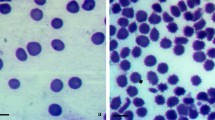Abstract
The major ingredient of Persicae Semen is a cynogenic compound, amygdalin (D-mandelonitrile-β-gentiobioside). Controversial results on the anticancer activity of amygdalin were reported due to its conversion to its inactive isomer, neoamygdalin. In order to inhibit the epimerization of amygdalin, we used newly developed simple acid boiling method in preparation of Persicae Semen extract. HPLC analysis revealed most of amygdalin in Persicae Semen extract was active D-form. Persicae Semen extract was used to analyze its effect on cell proliferation and induction of apoptosis in human promyelocytic leukemia (HL-60) cells. Persicae Semen extract was cytotoxic to HL-60 cells with IC50 of 6.4 mg/mL in the presence of 250 nM of (β-glucosidase. The antiproliferative effects of Persicae Semen extract appear to be attributable to its induction of apoptotic cell death, as Persicae Semen extract induced nuclear morphology changes and intemucleosomal DNA fragmentation.
Similar content being viewed by others
References
Bertrand, R. and Sane, A. T., Caspase inhibition in camptothecintreated U-937 is coupled with a shift from apoptosis to transient G1 arrest followed by necrotic cell death.Cancer Res., 59, 3565–3569 (1999).
Brimer, L., Cicalini, A. R., Federici, F., Nout, R. M., Petruccioli, M., and Pulci, V., Two-step hydrolysis of amygdalin in molds.Riv. Biol., 89, 493–496 (1996).
Dicenta, F., Martinez-Gomez, P., Grane, N., Martin, M. L., Leon, A., Canovas, J. A., and Berenguer, V., Relationship between cyanogenic compounds in kernels, leave and roots of sweet and bitter kernelled almonds.J. Agric. Food Chem., 50, 2149–2152 (2002).
Hyun, S. J., Yoon, M. Y., Kim, T. H., Kim, and J. H., Enhancement of mitogen-stimulated proliferation of low dose radiationadapted mouse splenocytes.Anticancer Res., 17, 225–229 (1997).
Hwang, E. Y., Lee, J. H., Lee, Y. M., and Hong, S. P., Reversephase HPLC separation of D-amygdalin and neoamygdalin optimum conditions for inhibition of racemization of amygdalin.Chem. Pharm. Bull., 50, 1373–1375 (2002).
Isozaki, T., Matano, Y., Yamamoto, K., and Kosaka, N., Quantitive determination of amygdain cpimers by cyclodextrin-modified micellar electrokinetic chromatography.J. Chrommatography A., 923, 249–254 (2001).
Kang, S. H., Jung, H., Kim, N., Shin, D. H., and Chung, D. S., Micellar electrokinetic chromatography for the analysis of Damygdalin its epimer in apricot kernel.J. Chromatogr A., 866, 253–259 (2000).
Kerr, J. R., Winterford, C. M., and Harmon, B. V., Apoptosis: Its significance in cancer and cancer therapy.Cancer, 73, 2013–2026 (1994).
Koeffler, H. P., Lowe, L., and Golde, D. W., Amygdalin (Laetrile): Effect on clonogenic cells from human myeloid leukemia cell lines and normal human marrow.Cancer Treat. Rep., 64, 105–109 (1980).
Lee, S. J., Ko, W. G., Kim, J. H., Sung, G. H., Lee, S. J., Moon, C. K., and Lee, B. H., Induction of apoptosis by a novel intestinal metabolite of Ginseng Saponin via cytochrome cmediated activation of Caspase-3 protease.Biochem. Pharm., 60, 667–685 (2000).
Lilenbaum, R. C. and Green, M. R., Novel chemotherapeutic agents in the treatment of non-small-cell lung cancer.J. Clin. Onco., 11, 1391–1402 (1993).
Lim, T. H., Leem, M. J., Shin, D. H., Chang, H. B., Hong, S. W., Moon, E. Y., Lee, D. K., Yoon, S. J., and Woo, W. S., Cytotoxic constituents from the roots ofAnthriscus sylvestris.Arch. Pharm. Res., 22, 208–212 (1999).
Llorens, O., Filizola, M., Spisani, S., Marastoni, M., Herranz, C., and Perez, J. J., Amygdain binds to the CD4 receptor as suggested from molecular modeling studies.Bioorg. Med. Chem. Lett., 8, 781–786 (1998).
Moertel, C. G., Pleming, T. R., Rubin, J., Kvols, L. K., Sarna, G., Koch, R., Currie, V. E., Yo, C. W., Jones, S. E., and Davignon, J. P.N. Engl. Med., 306, 201–206 (1982).
Monks, A., Scudiero, D., Skehan, P., Shoemaker, R., Paull, K., Vistica, D., Hose, C., Langley, J., Cronise, P., Vaigro-Wolff, A., Gray-Goodrich, M., Campbell, H., Mayo, J., and Boyd, M., Feasibility of a high-flux anticancer drug screening using a diverse panel of human tumor cell lines.J. Natl. Cancer Inst., 83, 757–766 (1991).
Newmark, J., Brady, R. O., Grimley, P. M., Gal, A. E., Waller, S. G., and Thistlethwaite, J. R., Amygdalin (Laetrile) and prunasin beta-glucosidases: Distribute in germ free rat and human tumor tissue.Proc. Natl. Acad. Sci. USA, 78, 6513–6516 (1981).
Pezzuto, J. M., Plant-derived anticancer agents.Biochem Pharm., 53, 121–133 (1997).
Strugala, G. J., Stahl, R., Elsenhans, B., Rauws, A. G., and Forth, W., Small-intestinal transfer mechanism of prunasin, the primary metabolite of the cyanogenic glycoside amygdain.Hum Exp Toxicol, 14, 895–901 (1995).
Syrigos, K. N., Rowlinson-Busza, G., and Epenetos, A. A.,In vitro cytotoxicity following specific activation of amygdain beta-glucosidase conjugated to a bladder cancer-associated monoclonal antibody.Int. J. Cancer, 78, 712–179 (1998).
Takayama, Y. and Kawai, S., Study on the prevention of racemization of amygdain.Chem. Pharm. Bull., 32, 772–781 (1984).
Yuan, D., Komatsu, K., Cui, Z., and Kano, Y., Pharmacological properties of traditional medicines. XXV. Effect of ephedrine, amygdalin, glycyrrhizin, gypsum and their combinations on body temperature and body fluid.Biol. Pharm. Bull., 22,165–171 (1999).
Author information
Authors and Affiliations
Corresponding author
Rights and permissions
About this article
Cite this article
Hee-Young, K., Seon-Pyo, H., Dong-Hoon, H. et al. Apoptosis induction of persicae semen extract in human promyelocytic leukemia (hl-60) cells. Arch Pharm Res 26, 157–161 (2003). https://doi.org/10.1007/BF02976663
Received:
Issue Date:
DOI: https://doi.org/10.1007/BF02976663




